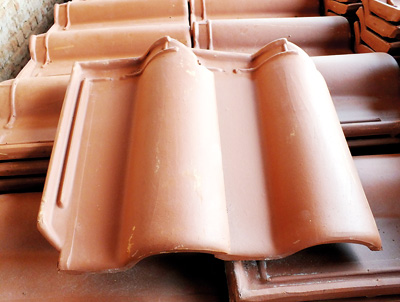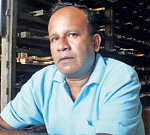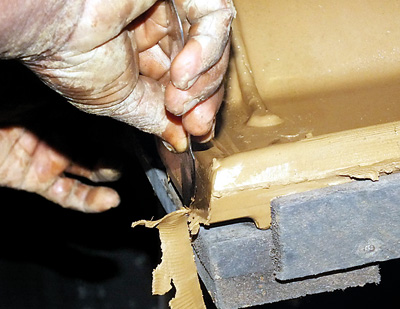Illegal sand mining adversely affecting the clay tile industry
Sri Lanka is known to be a country with a rich civilization, culture and industrial development some with a strong element of nature. The clay industry is one of them. Since ancient times tiles – Sinhala Ulu (tiles) – were manufactured the traditional way until the 1950s. With the advent of the present new clay tile manufacturing process, Sinhala Ulu faded away.

The finished tile
These industries that came down from generation to generation are now struggling to survive due to several difficulties, one of which is the negative attitude of certain government officials and agencies, entangled in a web of bribery and corruption. Other issues are foreign investors, the open market economy, etc. Unable to cope with the difficulties some of them have now pulled out of the industry. If these industries have been properly maintained and supported they would have transformed to become ‘world-class’ exports.
One such struggling industry is clay roofing tile manufacture with the main difficulty being sourcing the raw material – red clay. These tile makers have joined the Sri Lanka Ceramics and Glass Council (SLCGC). A joint venture floated by the SLSGC with the Centre for Technical Excellence in Ceramics (CENTEC) and the ITI (Industrial and Technology Institute) is now working on the development of industries using red clay.
Recently, SLCGC held its 6th symposium titled ‘Sri Lanka Ceramics and Glass – Powering Growth through Collaboration’ where its President, Mahendra Jayasekera said their deliberations would be devoted to develop the industries of tiles and bricks using red-clay and enumerated the difficulties and the solutions envisaged.

Jayantha Batepola President Tile Manufacturers Association
He said that no state agencies have given any help to industries using red clay for the last 30 years, making the statement in the presence of President Maithripala Sirisena who was the Chief Guest at the event.To find out the precise situation red clay tile manufacturers are facing, the Business Times (BT) travelled through the areas stretching from Kochchikade (Negombo), Thoppuwa (Thopputota) to Pannala, Giriulla covering about 20 km where around 150 tile factories are perched in the vicinity of the Ma-Oya (river).
At Thoppuwa, the BT met Jayantha Batepola, President, Tile Manufacturers Association (TMA) at his tile factory ‘Rathna Tiles’. TMA has a membership of 150 out of around 225 tile producers. Ajith Batepola, Propaganda Secretary, All Island Clay Roofing Tile Manufacturers Association which is the main representative body of the tile manufacturers of which TMA is a part, said that while there were more than 600 clay tile manufacturers in Sri Lanka, the number has reduced to around 200 to 225. This was due to the difficulty of finding the necessary clay and due to the invasion of asbestos in building materials.

Once the final tile comes out of the machine, final touches are given
The industry draws almost its entire workforce from around these factories. The TMA President said that more than 1,500 are working in these factories with another 50,000 in indirect employment. Both Batepolas’ said that before 2004 the clay roofing tile industry did not face any difficulty in their manufacture. However during that time there was a fundamental rights issue raised by two tile manufacturers at the Supreme Court with former Chief Justice Sarath N Silva heading the 3-member bench. Under the court ruling, some restrictions were placed such as no clay mining allowed within 150 metres from the river bank and banning the use of heavy machinery in mining.
The licence allows only 10 cubic metres per month per factory which is hardly sufficient. Thus the factories are run at 25 per cent capacity. Local demand could be fully met with 50 per cent capacity. What tile manufacturers are contemplating is to get enough supplies and run at 100 per cent and export. Somewhere in 2004, the TMA President said they exported a consignment to South Africa.
Regulations create an impasse and their plight is precarious, he said, adding that nothing moves without bribery. Lorries transporting clay and tiles are normally intercepted by the police and whether one has the licence or not the bribes usually run from Rs.300 to 500 and refusal to pay means going to courts and ending up with a cost of about Rs. 50,000. Clay mining is not as hazardous as sand mining but clay mining has got entrenched with sand mining issues.
The scene on the banks of the Ma-oya was unbelievable with gigantic water holes carved some as large an area as 10 acres. Corruption in sand mining is so high and action is taken against criminal elements involved in illegal sand mining.
While the authorities fail to take action, groups of residents living near the river are seeking court intervention to refill these huge water holes. Tile factory owners say that once the clay excavation is over the holes are filled with gravel and the land could be planted with coconut or built on depending on land prices.
Mr. Jayantha Batepola said that clay is available everywhere in this area. The danger however is when sand mining starts after clay excavation is over. Some tile manufacturers pointed out that to bring in some stability in the tile trade, first the existing regulations have to be reviewed and on top there should be a set of honest officials to monitor clay mining and eliminate bribery and corruption. They noted that there should be a multi-pronged approach of trade and employment potential, environment and benefit to the national economy which can come through the clay tile industry.


